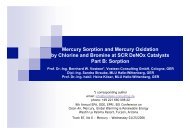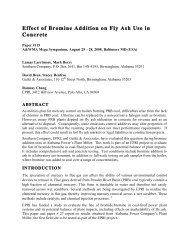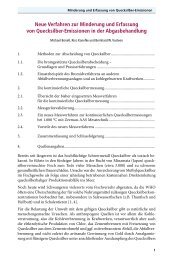08 Vosteen_E_Umbruch - Vosteen Consulting GmbH
08 Vosteen_E_Umbruch - Vosteen Consulting GmbH
08 Vosteen_E_Umbruch - Vosteen Consulting GmbH
Create successful ePaper yourself
Turn your PDF publications into a flip-book with our unique Google optimized e-Paper software.
e operated strictly isothermal. Therefore, the slag within the kiln<br />
would be either immobile (like “ice”) or highly mobile (like “water”),<br />
while “slagging” and “axial slag transport” necessitate both, a mobile<br />
slag film on top of an immobile frozen slag-layer.<br />
Industrial Results<br />
By “thermographically controlled slagging”, based on “simultaneous<br />
inner and outer thermography”, as described in this paper, the brick<br />
life of KILN A (formerly only 6000 to 7000 hours) was considerably<br />
increased, see Figure 14a, indicating that the brick life of this kiln –<br />
after almost 20,000 operational hours – has not yet come to its end. A<br />
new bricklining was installed after 21,776 operational hours in March<br />
2002.<br />
Figure 14b describes the corresponding results at the other KILN B<br />
(with formerly some 20,000 hours brick life), indicating that the application<br />
of “thermographically controlled slagging will prolong the<br />
brick life of this kiln up to possibly some 40,000 hours.<br />
Under actual waste management aspects, the applied method has an<br />
additional advantage: A thermographically-controlled kiln can be operated<br />
until a minimal residual brick thickness has been reached indeed.<br />
This advantage became obvious at the end of 1998, enabling a<br />
prolonged operation of KILN A until April 1999, giving five months<br />
time for maintenance works at other kilns.<br />
Final remarks: A kiln mustn’t always be slagged as heavily as shown<br />
in Figure 15a. But slagging only decently – as shown in Figure<br />
15b – might not be sufficient for brick protection.<br />
Summary and Conclusions<br />
It has been demonstrated that “thermographically-controlled slagging”<br />
can be successfully applied to the industrial operation of rotary kiln incinerators<br />
and that the developed new method, reducing brick wear to<br />
less than 50 mm/year, will prolong brick life considerably to 20,000 h<br />
and possibly far more. The applied method enables the plant operations<br />
manager to forecast the next required kiln shutdown more exactly,<br />
not requiring intermediate kiln shutdowns to verify brick thickness<br />
by drilling. The investment for the thermographical hardware has been<br />
returned – by reduction of brick wear at two neighboured kilns – within<br />
less than six months.<br />
The authors would like to thank all colleagues and plant personnel involved<br />
in the described developmental work and its industrial application.<br />
Special thanks to Dipl.-Ing. Franz-Josef Johann (final diploma<br />
thesis on “Thermography”), to Dipl.-Ing. Marcus Simon (final diploma<br />
thesis on “Melting Behaviour and Kiln Slagging”) as students with<br />
Professor <strong>Vosteen</strong> and to Dipl.-Ing. Maria Fayos-Galan as post graduate<br />
student for valuable contributions, and finally to Dr. Klaus Hagemeyer,<br />
re-designing the software “RotaVos” for commercial use.<br />
References<br />
[1] <strong>Vosteen</strong>, B., and Beyer, J.: Obtainable Residual Carbon Content in Slags<br />
and Ashes from Waste Incineration Systems. Part I: Fixed Carbon as a<br />
Waste Property and Fixed Carbon Burn-Up in Different Waste Incinerators.<br />
VGB PowerTech 80 (2000), No. 9, pp. 48 – 52.<br />
[2] <strong>Vosteen</strong>, B., and Beyer, J.: Obtainable Residual Carbon Content in Slags<br />
and Ashes from Waste Incineration Systems. Part II: Loss on Ignition and<br />
Residual Carbon in Ashes from Municipal Solid Waste Incinerator Plants<br />
(MSWIP) and in Slags from Hazardous Waste Incinerator Plants (HWIP).<br />
VGB PowerTech 80 (2000), No. 10, pp. 74 – 75.<br />
[3] Reich, J.: Optimierung des Eluationsverhaltens von Aschen aus der<br />
Sonderabfallverbrennung. Dissertation Gerhard-Mercator-Universität –<br />
Gesamthochschule Duisburg, March 12, 2001.<br />
[4] R. Ullrich, WastePro Engineering Inc., PA (USA): Personal note to the<br />
authors in 2001 about an application of outer cooling fans, combined with<br />
the addition of sand and recycled slag.<br />
VGB PowerTech 9/2002 77







